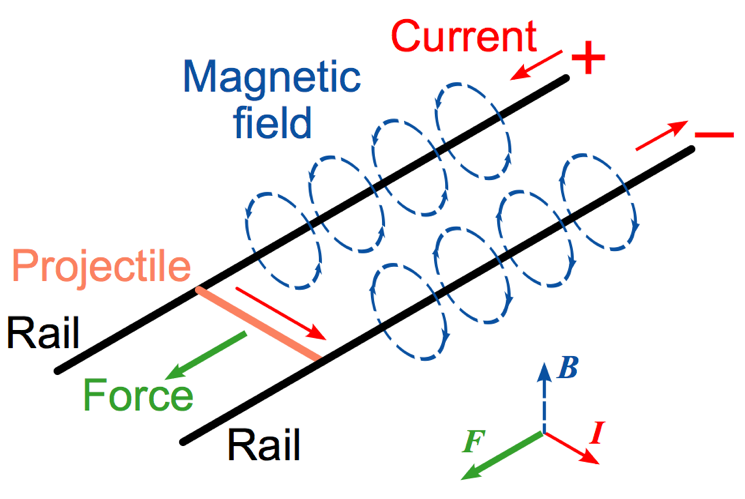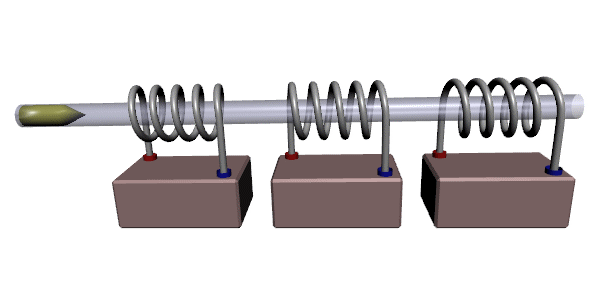Railgun - the weapon of the future

Hello from Quake 3 Arena
Railgun, or in common "rail" - a pulsed electrode mass accelerator, the principle of which is explained by the Lorentz force, which converts electrical energy into kinetic. It is a promising weapon that has several advantages over the classical layout based on a chemical explosion. And the combat trials of this beauty is not far off.
Principle of operation and limitations
The rail gun uses an electromagnetic force, called the Lorentz force, to accelerate an electrically conducting projectile, which is initially part of the circuit. Sometimes movable armature connecting the rails is used. The current I going through the rails excites the magnetic field B between them, perpendicular to the current passing through the projectile and the adjacent rail. The result is a mutual repulsion of the rails and the acceleration of the projectile under the action of the force F.

One of the problems of the railgun is that the manufacture of its projectiles requires a material with the highest possible conductivity, since to create a driving force on the rails starts a very powerful instantaneous discharge current. If the material of the projectile has insufficient conductivity, it can evaporate in the railgun under the influence of current before leaving the gun.
')
The second limiter is the power supply. In the near future, the US Navy plans to test the railgun at the base of the ship (only the ship today can withstand a shot from this weapon). For a volley from a modern railgun, an impulse of 25 (!) Megawatts is required. One of the ships of the US Navy, which was designed specifically with the possibility of a railgun assembly, is equipped with 78 megawatt power plants, and the most common value of electric. power plant on the ship is the figure of 9 megawatts. For one shot of the railgun it takes almost 30% of the power of the installation of the spec. ship fleet. On the use of this type of weapons on ordinary ships and think not worth it.
Video from the US Navy experimental setup:
Question to the hall: where did the fiery flash come from? :)
Sometimes, to give the railgun projectile the highest initial velocity, in the presence of which the shot will be more effective, a chemical explosion is produced (detonation of gunpowder, for example). Exaggerating, the railgun can be used as an “accelerating nozzle” for guns, which increases the velocity of the projectile at the exit. But I would not dare to pass such a current through explosives.
Non-conductive projectile
There is another kind of railgun that uses a non-conductive projectile. In the case described, the rails are closed not by the projectile itself, which leads to the formation of Lorentz force, but separately, behind the projectile, forming an arc discharge. The latter leads to the evaporation of the projectile and the formation of a jet stream, which, moving the projectile along the rails, accelerates it.
Not to be confused with the Gauss gun
The Gauss gun and the railgun are often confused. The reason for this is the similar nature of the operation of these devices, but they use different approaches and electro-physical laws to disperse the projectile. In the railgun realized the use of Lorentz force or jet stream, and in the Gauss gun - the use of electromagnetic fields. A projectile from a ferromagnet accelerates through a dielectric tube through a series of solenoids, which, when turned on, form a magnetic field that “pushes” the projectile from the ferromagnet forward.

The Gauss gun has a efficiency much lower than that of the railgun, so the principle for creating weapons is not considered by the military.
So why is such a complicated railgun so tasty for the military?
Everything before the banal is simple - money. “Rail” is capable of firing at a distance of up to 180 km today, and in the future it is planned to reach indicators up to 400 km. It is possible to fire at such distances only with the help of rockets, each of which is worth millions of dollars, plus everything can be fought with. Railgun already now can fire with projectiles weighing 2-3 kg, which at a speed of up to 2000-2500 m / s leads to enormous destruction. The projectile itself costs about $ 20-25 thousand, compared to the cost of the missiles — free of charge, and the transportation and operation of such ammunition is a pleasure: the ammunition assembly does not detonate, there are no problems with loading, no emergencies due to the human factor (if, of course, -Not let her drop on her leg).
Scientists have to solve the problem only with the power source, because building ships specifically under the “rail” is very expensive (a 70 megawatt power plant is the power consumption of a small city). As soon as the issue of nutrition is resolved, we will be able to see the railgun in service. And how to deal with a three-kilogram block, flying at a speed of 7 Mach and capable of sinking the ship - is not clear.
That's how we live.
Source: https://habr.com/ru/post/376777/
All Articles